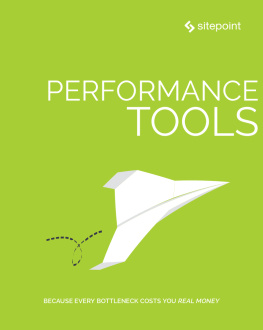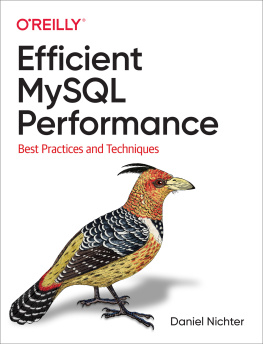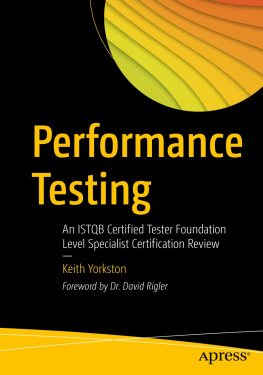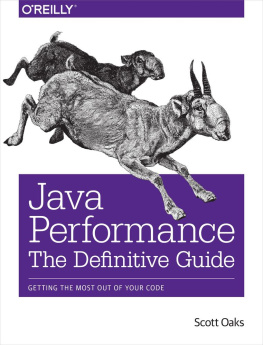About This eBook
ePUB is an open, industry-standard format for eBooks. However, support of ePUB and its many features varies across reading devices and applications. Use your device or app settings to customize the presentation to your liking. Settings that you can customize often include font, font size, single or double column, landscape or portrait mode, and figures that you can click or tap to enlarge. For additional information about the settings and features on your reading device or app, visit the device manufacturers Web site.
Many titles include programming code or configuration examples. To optimize the presentation of these elements, view the eBook in single-column, landscape mode and adjust the font size to the smallest setting. In addition to presenting code and configurations in the reflowable text format, we have included images of the code that mimic the presentation found in the print book; therefore, where the reflowable format may compromise the presentation of the code listing, you will see a Click here to view code image link. Click the link to view the print-fidelity code image. To return to the previous page viewed, click the Back button on your device or app.
Foundations of Software and System Performance Engineering
Process, Performance Modeling, Requirements, Testing, Scalability, and Practice
Andr B. Bondi

Upper Saddle River, NJ Boston Indianapolis San Francisco
New York Toronto Montreal London Munich Paris Madrid
Capetown Sydney Tokyo Singapore Mexico City
Many of the designations used by manufacturers and sellers to distinguish their products are claimed as trademarks. Where those designations appear in this book, and the publisher was aware of a trademark claim, the designations have been printed with initial capital letters or in all capitals.
The author and publisher have taken care in the preparation of this book, but make no expressed or implied warranty of any kind and assume no responsibility for errors or omissions. No liability is assumed for incidental or consequential damages in connection with or arising out of the use of the information or programs contained herein.
For information about buying this title in bulk quantities, or for special sales opportunities (which may include electronic versions; custom cover designs; and content particular to your business, training goals, marketing focus, or branding interests), please contact our corporate sales department at or (800) 382-3419.
For government sales inquiries, please contact .
For questions about sales outside the United States, please contact .
Visit us on the Web: informit.com/aw
Library of Congress Cataloging-in-Publication Data
Bondi, Andr B., author.
Foundations of software and system performance engineering : process, performance
modeling, requirements, testing, scalability, and practice / Andr B. Bondi.
pages cm
Includes bibliographical references and index.
ISBN 978-0-321-83382-2 (pbk. : alk. paper)
1. Computer systemsEvaluation. 2. Computer systemsReliability. 3. Computer
softwareValidation. 4. Computer architectureEvaluation. 5. System engineering.
I. Title.
QA76.9.E94B66 2015
005.14dc23
2014020070
Copyright 2015 Pearson Education, Inc.
All rights reserved. Printed in the United States of America. This publication is protected by copyright, and permission must be obtained from the publisher prior to any prohibited reproduction, storage in a retrieval system, or transmission in any form or by any means, electronic, mechanical, photocopying, recording, or likewise. For information regarding permissions, request forms and the appropriate contacts within the Pearson Education Global Rights & Permissions Department, please visit www.pearsoned.com/permissions/.
ISBN-13: 978-0-321-83382-2
ISBN-10: 0-321-83382-1
2 16
Executive Editor
Bernard Goodwin
Senior Development Editor
Chris Zahn
Managing Editor
John Fuller
Senior Project Editor
Kesel Wilson
Copy Editor
Barbara Wood
Indexer
Jack Lewis
Proofreader
Andrea Fox
Editorial Assistant
Michelle Housley
Cover Designer
Alan Clements
Compositor
LaurelTech
Praise for Foundations of Software and System Performance Engineering
If this book had only been available to the contractors building healthcare.gov, and they read and followed the lifecycle performance processes, there would not have been the enormous problems apparent in that health care application. In my 40-plus years of experience in building leading-edge software and hardware products, poor performance is the single most frequent cause of the failure or cancellation of a new, software-intensive project. Performance requirements are often neglected or poorly formulated during the planning and requirements phases of a project. Consequently, the software architecture and the resulting delivered system are unable to meet performance needs. This book provides the reader with the techniques and skills necessary to implement performance engineering at the beginning of a project and manage those requirements throughout the lifecycle of the product. I cannot recommend this book highly enough.
Don Shafer, CSDP, Technical Fellow, Athens Group, LLC
Well written and packed with useful examples, Foundations of Software and System Performance Engineering provides a thorough presentation of this crucial topic. Drawing upon decades of professional experience, Dr. Bondi shows how the principles of performance engineering can be applied in many different fields and disciplines.
Matthew Scarpino, author of Programming the Cell Processor and OpenCL in Action
In memory of my father, Henry S. Bondi,
who liked eclectic solutions to problems,
and of my violin teacher, Fritz Rikko,
who taught me how to analyze and debug.
tous qui ont attendu.
Preface
The performance engineering of computer systems and the systems they control concerns the methods, practices, and disciplines that may be used to ensure that the systems provide the performance that is expected of them. Performance engineering is a process that touches every aspect of the software lifecycle, from conception and requirements planning to testing and delivery. Failure to address performance concerns at the beginning of the software lifecycle significantly increases the risk that a software project will fail. Indeed, performance is the single largest risk to the success of any software project. Readers in the United States will recall that poor performance was the first sign that healthcare.gov, the federal web site for obtaining health insurance policies that went online in late 2013, was having a very poor start. News reports indicate that the processes and steps recommended in this book were not followed during its development and rollout. Performance requirements were inadequately specified, and there was almost no performance testing prior to the rollout because time was not available for it. This should be a warning that adequate planning and timely scheduling are preconditions for the successful incorporation of performance engineering into the software development lifecycle. Building and then tuning is an almost certain recipe for performance failure.
Scope and Purpose








